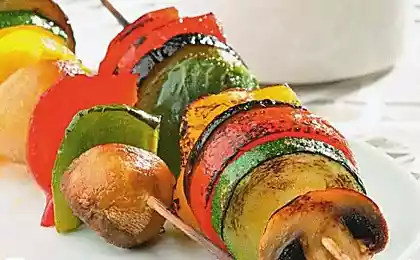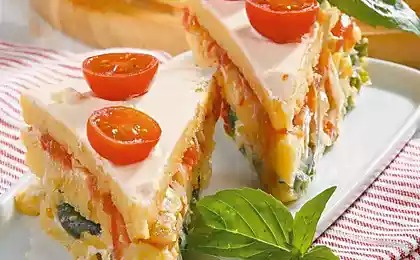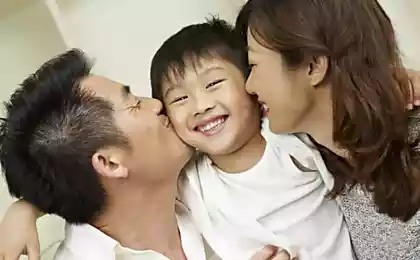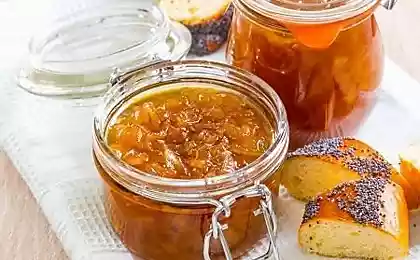1050
Chinese tombs of the Ming Dynasty
Complex Shisanlin or 13 tombs of the Ming emperors, located 30 kilometers north of Beijing. I stop here often tour buses going to the Great Wall in Badaling area. Because of its availability in the Ming tombs Shisanlin have long been promoted tourist attraction.
For the first time in the history of China has opened the tomb of one of the emperors - Wanli, which is now demonstrating to tourists. So now, not only Shisanlin majestic memorial Minsk imperial dynasty, but also a monument to the painful birth of Chinese archeology ...
38 photos
via maximus101
1. The corridor leading to the burial chamber of the tomb Dinlin.
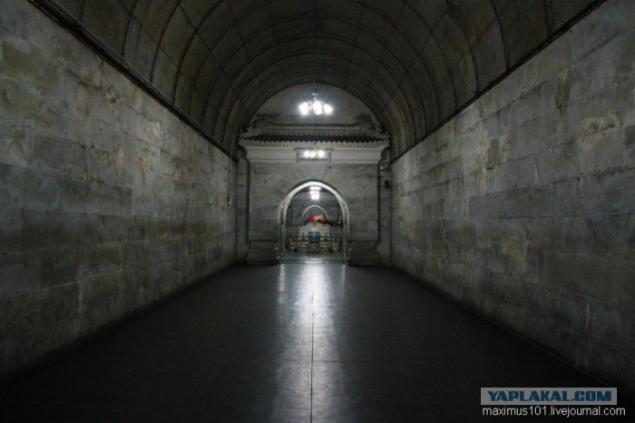
2. You can often hear that this necropolis is not impressive, even in spite of its enormous historical significance. I probably agree, in my opinion, dumping the Qing emperors in Tsindunline east of Beijing is much more interesting, there are more tombs open to the public and the district itself is not so "spoiled" by human activity. Ming tombs are located too close to Beijing and in connection with this entire complex is built up much various outbuildings, settlements, etc.

3. But Shisanlin has an advantage, it is, above all, the huge size of the tombs. However, due to the fact that the burial hills heavily overgrown forest and economic development around the chaos, it is not very obvious to tourists. But the fact remains - for example, the diameter of the burial hill, first buried here Emperor Yongle, is 310 meters, and a circle about 1 km! I have no idea, what is the height of the mound was in the 15th century when it was built, but now it's somewhere meter 30. It is clear that the earth is "settled" for centuries, rain and wind do their job. But even now, the burial mound Yongle can compete in size with the ancient pyramid of China's first emperor Qin Shi Huang, under Xi'an, which also lost much in height over the millennia. Only a few have ever seen the pyramids in China fall short of the area to the Ming Emperor Yongle of the mound.
The layout of the mausoleum of Emperor Yongle, something like almost all vygledyat Ming tombs.
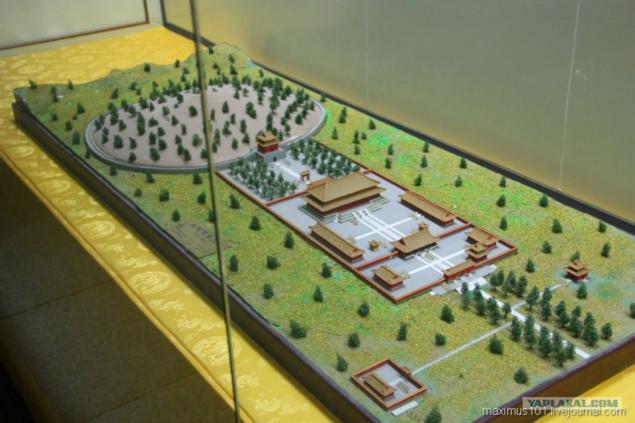
4. There is an interesting touch on the question of the form of burial structures of the Ming dynasty. It is unclear why the Ming emperor chose circular burial mounds. The fact that all the old Chinese burial hills, namely Tsin, and Han Sung pyramids were always exclusively a square base. Only the states of Northern Wei emperors built the "round" pyramidal structures, but it was kitaezirovannaya nomads tobgachey Dynasty, "the Chinese are not quite", so to speak. Visions of me pyramid subsequent Chinese Tang and Song dynasties have been square in plan, like all the others. The question arises why the emperors of the Ming Dynasty overthrew nomadic, again, the Mongol Yuan dynasty, and considers himself a real Chinese, and the best traditions of the Han state, changed the shape of their graves? After all, in the Chinese tradition - it is not an empty phrase. To this I have no answer ... The outer wall of the burial tomb Dinlin hill. The wall serves as additional protection of burial chambers and did not allow the earthen mound "sprawl."
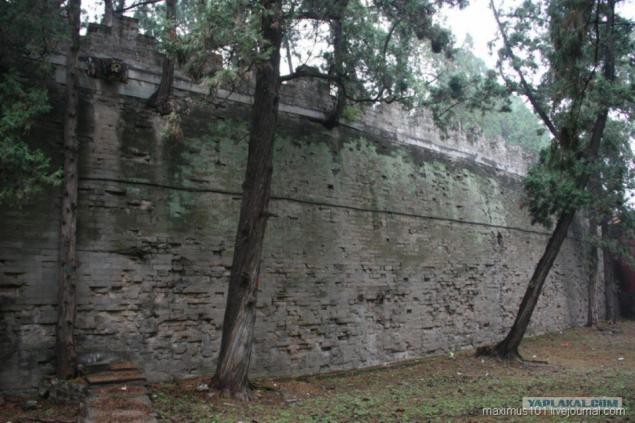
5. Kurgan Dinlin.

6. Upper Playground wall strengthens burial mound.
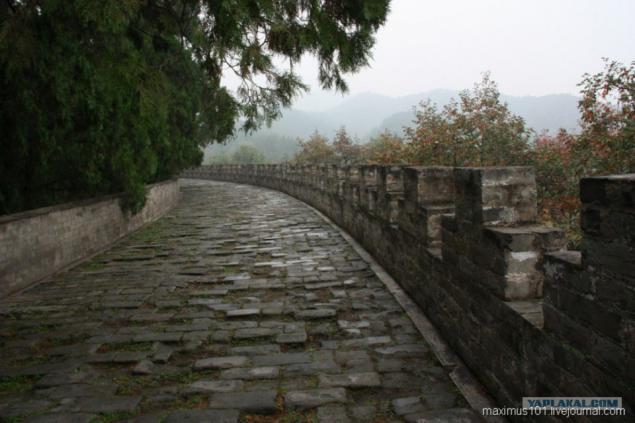
7. The road to the tomb Dinlin.
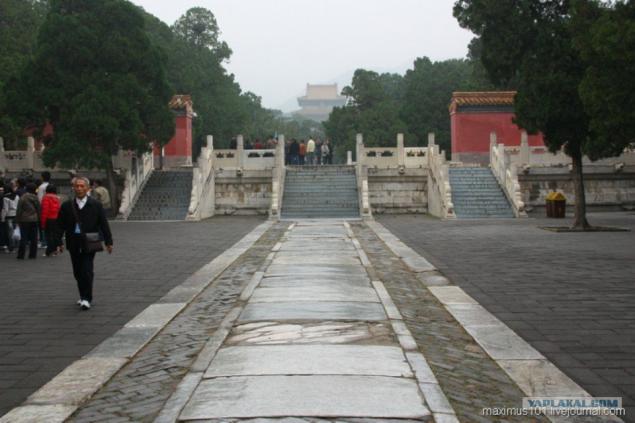
8. All Chinese burial structures have almost the same structure - it's a long road to the main complex, fenced walls, inside the walls of a few yards from the wooden pavilion - a temple for the Souls of emperors and, actually, the burial mound. They differ only in size and degree of preservation.
Ruins "memorial hall".
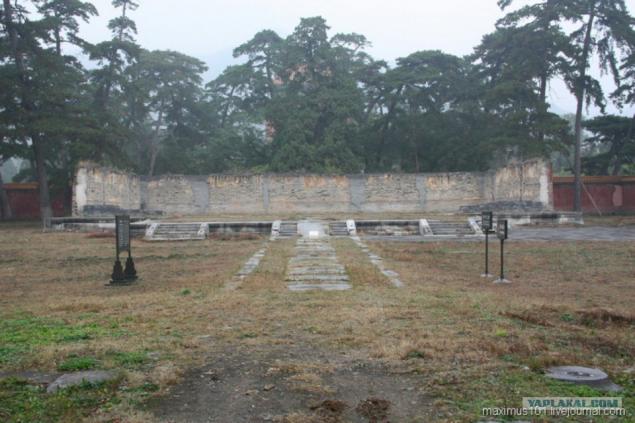
9. "Funerary Tower" - the tomb Kanlin Fanchen.
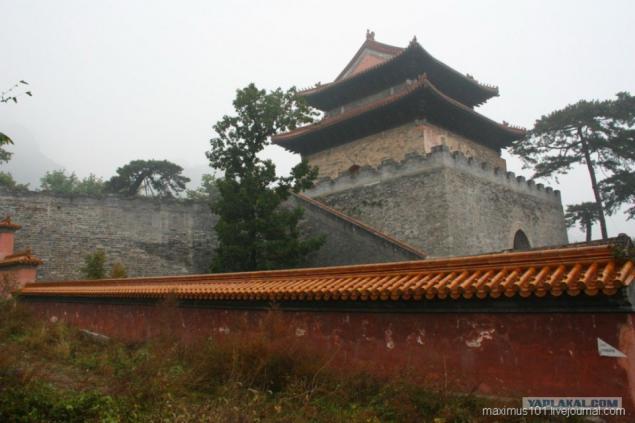
10. So watch all the 13 tombs in Shisanlin has no thoughts, especially almost all of them are closed for visiting, you can not even get into the courtyard, you can only stare from behind the walls. Private entrance to the tomb Kanlin.
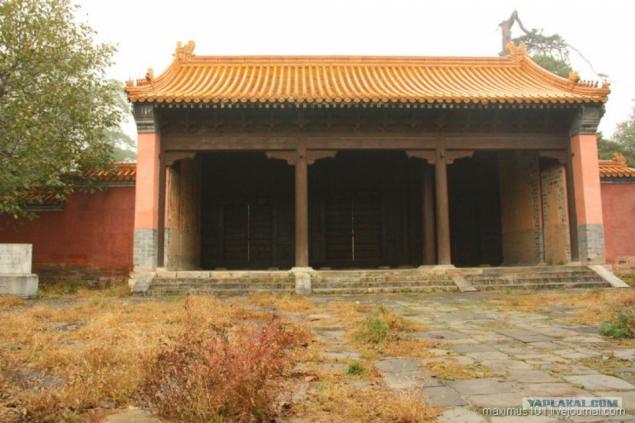
11.
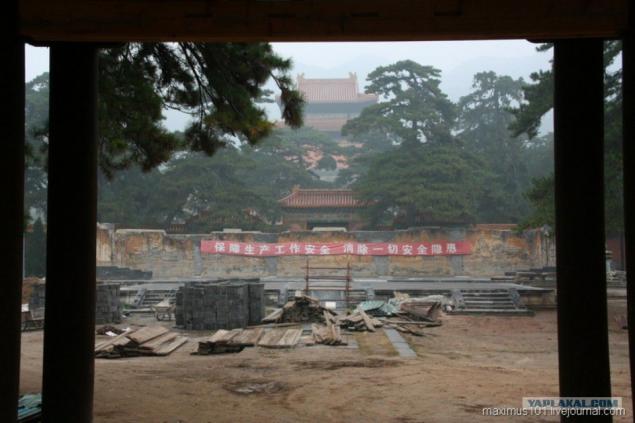
12. The courtyards are open only three Changling Tomb, Dinlin and Zhaolin - Emperor Zhu Di, the motto of the Board Yongle (1360-1424 gg.), Zhu Inzyun motto Wanli reign (1563-1620 gg.) And Zhu Tszayhou motto Luntsin ( 1537-1572 gg.) To avoid confusion, I mention here only the motto of the emperors - Yongle, Wanli, etc. The main memorial hall of the tomb of Changling - Linendyan.
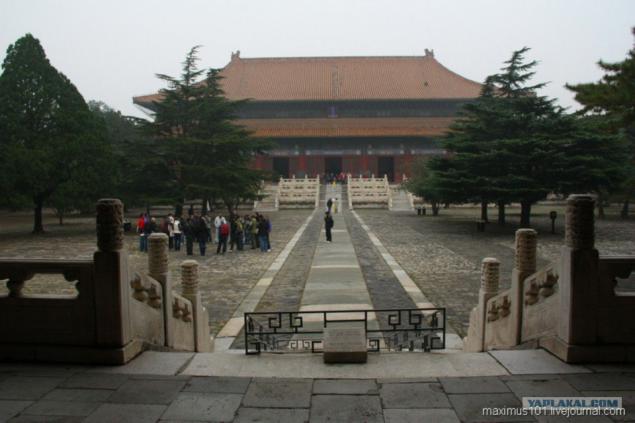
13.
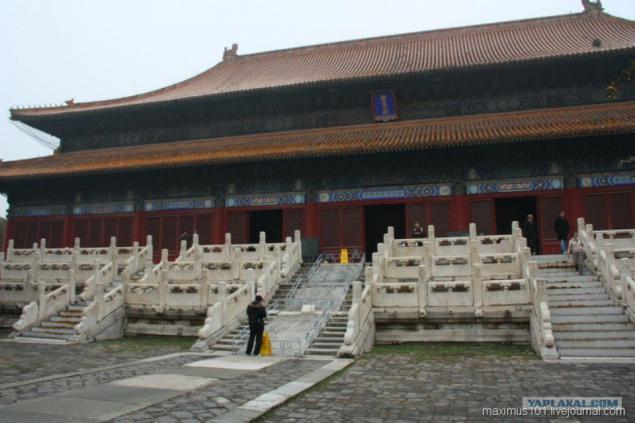
14.
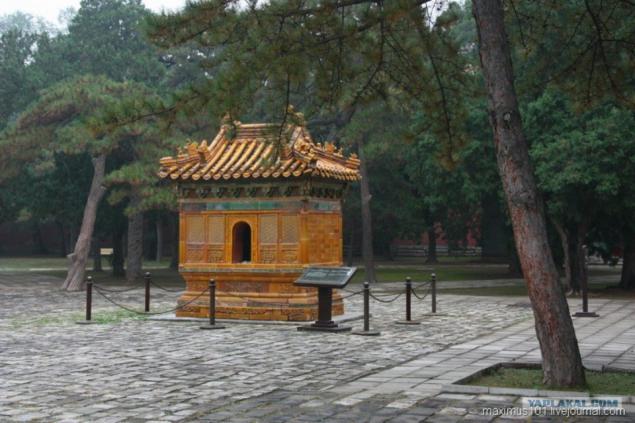
15. Now, at that time the authorities in China are very reluctant to opening the imperial tombs. Despite the external "communist gloss", the Chinese rulers strongly influenced by Confucian morality and various forms of folk beliefs, the belief in spirits, the notorious feng shui, etc. Therefore disturb ashes of the emperors considered not very useful for the society in general and the governor, in particular, employment. It can be self-fulfilling "displeasure spirits", and something goes wrong, in general, it is better not to risk it. And in order to justify it somehow obscurantism, the Chinese authorities have come up with various reasons, do not touch the tomb, for example, says that "we currently do not have the equipment to secure the preservation of historic values." Very often this is indeed so, but the striking fact that the tomb be opened less important people are very active. Do not touch only the significant characters of Chinese history. Apparently, it is believed that the "powerful" the emperor was in life, the more trouble may happen by opening his grave ...
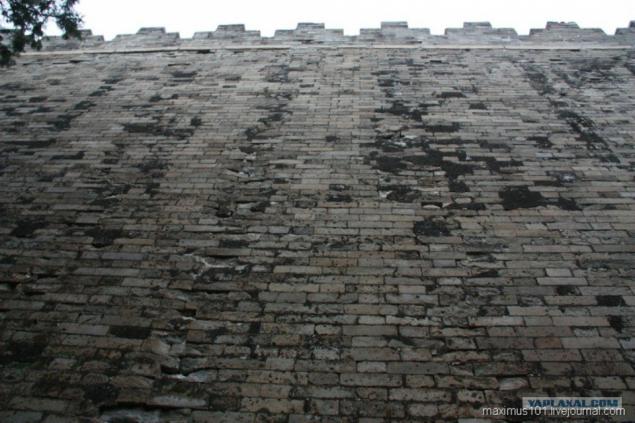
16. Tomb of the great Emperor Yongle, the conqueror of the Mongols, the builder of the Forbidden City in Beijing, sent the Admiral Zheng Heh sail on the seas, would open in 1956, but still lay. The same thing happens with the famous pyramid of the first emperor Qin Shi Huang. By the way, here, in my opinion, has a well-known myth about the birth of the Chinese pyramids and their supposedly terrible inaccessibility, popular rumor is always under some kind of a base. The Chinese, in fact, trying to distance himself somewhat in this regard and little cover their research graves. My opinion is that they can not until the end decide for themselves how to develop its archeology and at the same time honor the memory of great ancestors.
Tower Fanchen before burial mounds Changling, Emperor Yongle. Very often in this tower began descending tunnel leading to the burial chamber.

17.

18.

19. The often cited example of the fate of the first opening of the imperial burial - in the tomb Dinlin Shisanlin. Initially, in 1956 there was a plan of excavation of the large mound necropolis in Minsk Changling - Emperor Yongle, it approved the "second sun" of the Communist Party of China - Zhou Enlai. But then, "because of the high social significance" Changling tomb, it was decided to work out at the "archaeological research" on anything more "shallow", this was the burial place of Emperor Wanli, the tomb Dinlin.
Linendyan Pavilion Changling tomb.
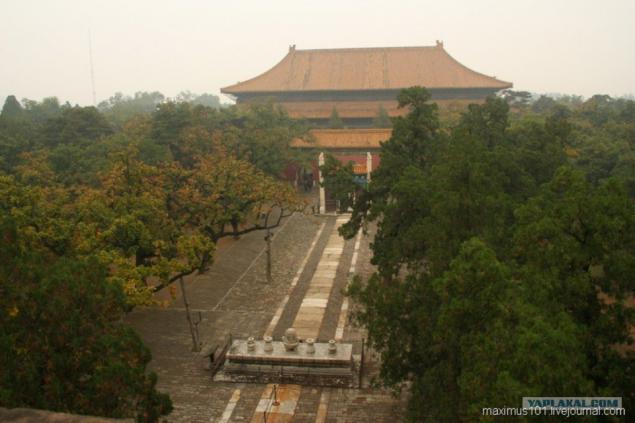
20.
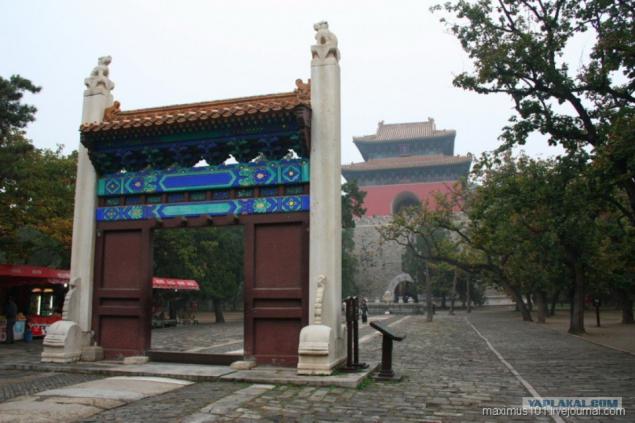
21. Wanli famous in Chinese history only by its gluttony and extravagance, though propravil much as 47 years, so it would not dig so sorry. Besides, his tomb was too large in size, the diameter of the burial mound Dinlin 230 meters, it was possible to train enough.
Without much effort hit several mines in the interior of the mound Chinese "archaeologists" found the burial chamber Wanli. And then it turned out that was completely untouched Dinlin tomb. In the main crypt he attended Wanli himself, his two wives and their many riches. All more or less valuable, according to the ideas, the then Chinese "scholars" were gutted from burial chambers, first of all, it was the jewelry, and the rest of the "garbage", in the form of wooden sarcophagi, silks, various utensils and most Wanli wives was dumped in a shed.
Photography remains Wanli made in 1956 during excavations Dinlin. I must say that for his age, and it took almost 400 years old, he is very good looking ...
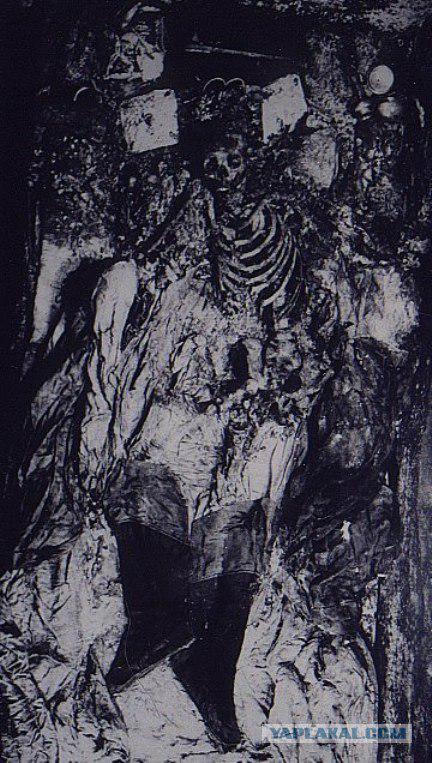
22. The story is not over the ill-fated Emperor, during the subsequent Cultural Revolution, the remains of Wanli and his wife were solemnly burned the Red Guards, a large gathering of people. Thus it was finally destroyed by the tyrant bloodsucker and the common people. By the way, most of the "archaeologists" digging Dinlin, also survived the Cultural Revolution.
Hats from the tomb of the imperial family Dinlin.
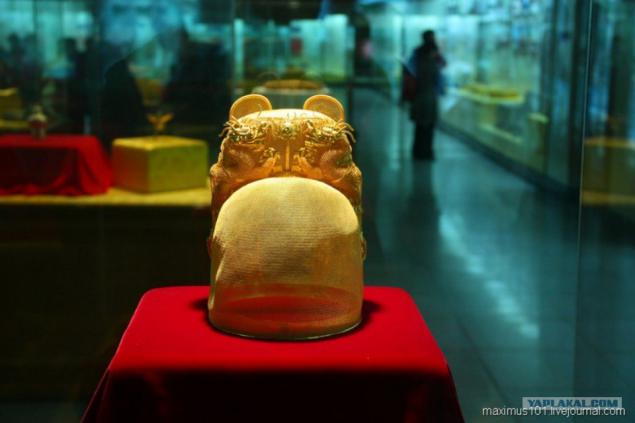
23.
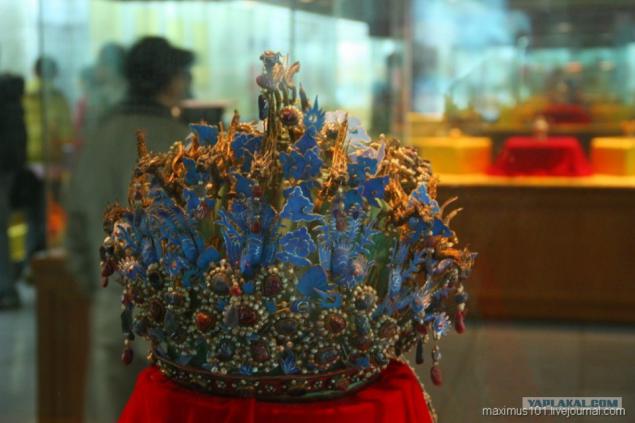
24.
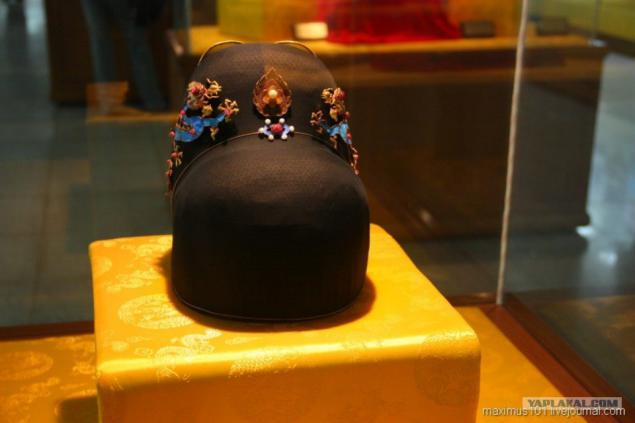
25. In today's day Chinese academia like to cite an example of "research" in Dinlin and add at the same time - do you really want all the other graves would be the same thing ... So it is better not to touch anything ... And still more to dig the graves of petty officials and concubines .
The funeral hall in Dinlin intended for concubines. He remained empty. Mountain green paper on the floor - Chinese yuan.

26. The main burial room with a mock coffin Dinlin Wanli and his two wives. Layouts are made quite clumsy, I personally can not believe that the imperial tombs were established, all I've seen a real Chinese sarcophagi were very elaborately decorated, it is unclear why the coffins Dinlin are exceptions ...
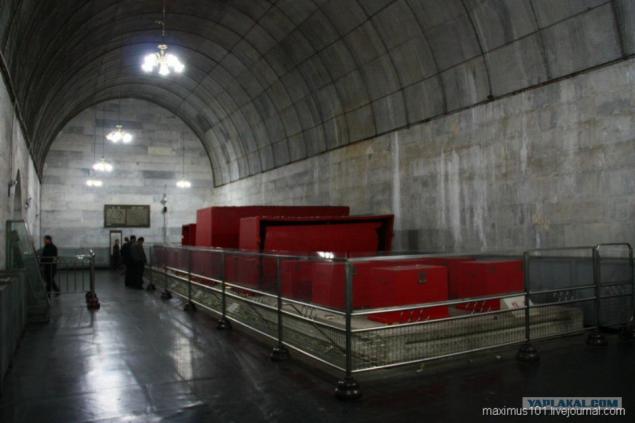
27.

28. The long hall at the entrance to the main burial chamber.
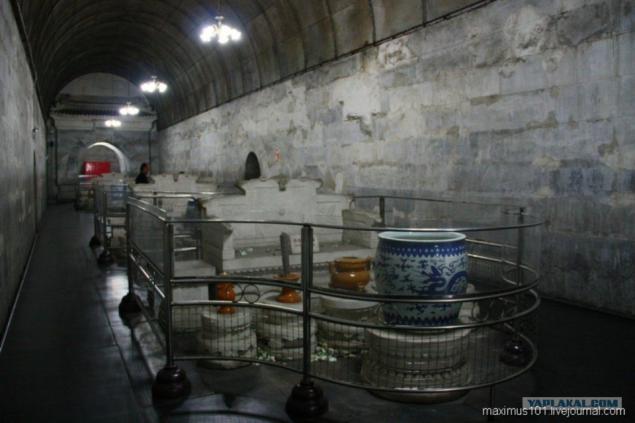
29. Lamps have been filled with oil and had to shine forever ...
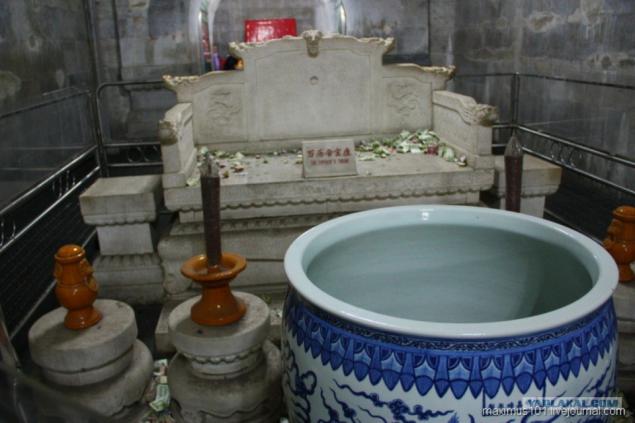
30.
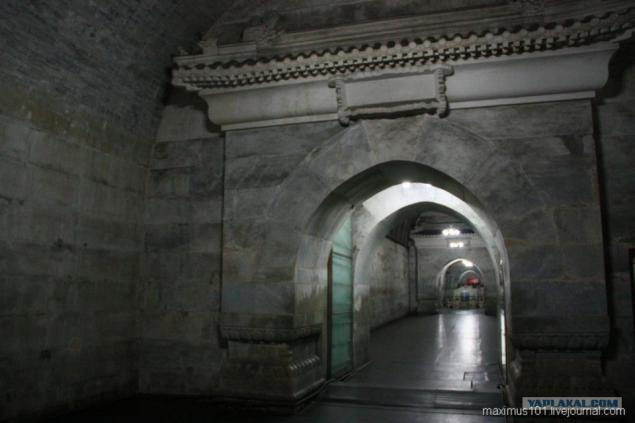
31.
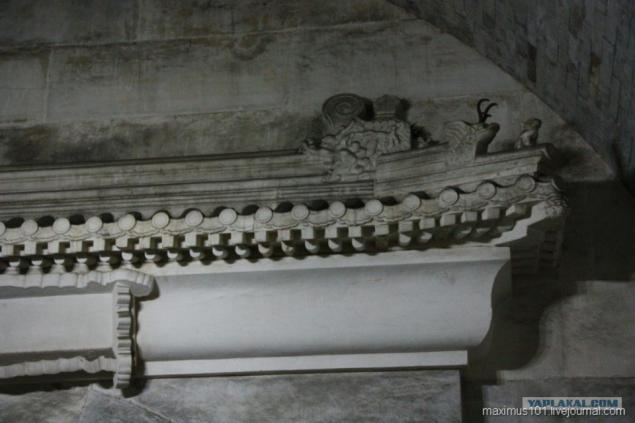
32. Exit the tomb, these structures were built in 60 years, instead of the horizontal tunnel. Naturally, the historic entrance to the tomb was completely destroyed.
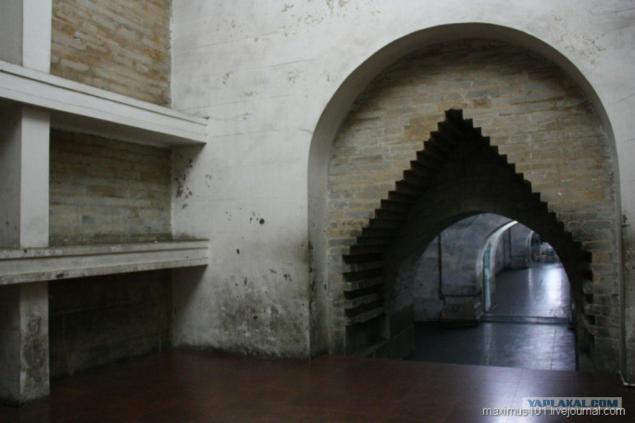
33. Why was it necessary to fence these modern designs are not very clear. By the way, the entrance to the tomb through a similar mine with ladders, the mine falls into the "Hall of concubines."
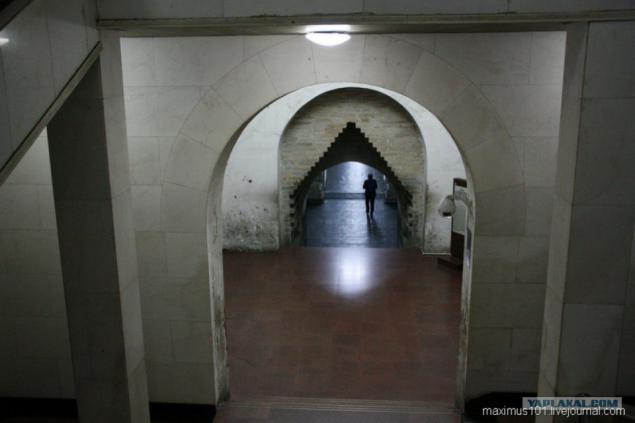
34. The modern way to the surface, most likely, these Chinese designs were necessary to hide, they dug during the excavations, monstrous excavations in the burial hill.
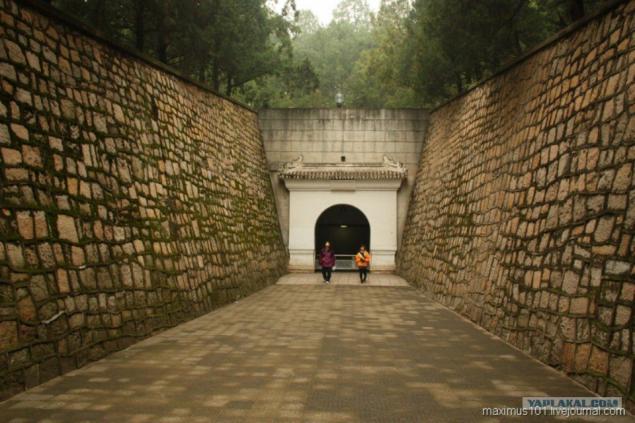
35. Stella turtle at the entrance to the tomb of Changling, the turtle is simply awash in cash.
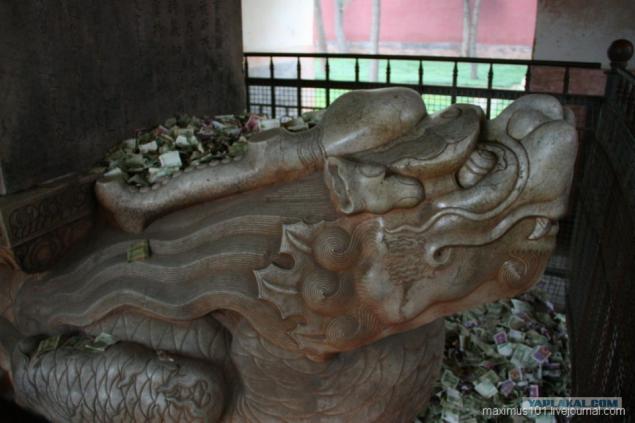
36.
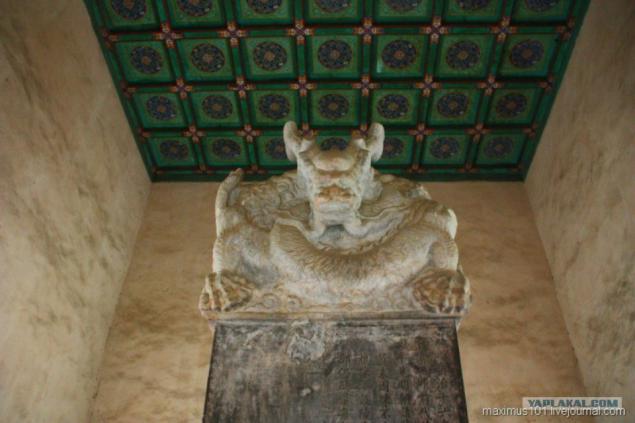
37. The outer wall of the burial hill Kanlin and classical Chinese landscape in the background. Ming Tombs worth seeing if only for the local mountain scenery.
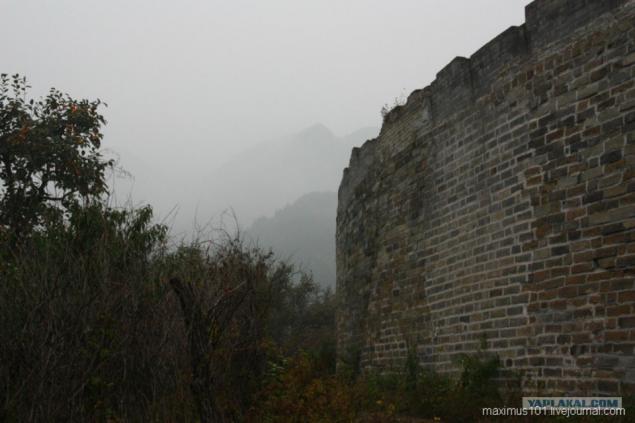
38. Autumn in Shisanlin.
All
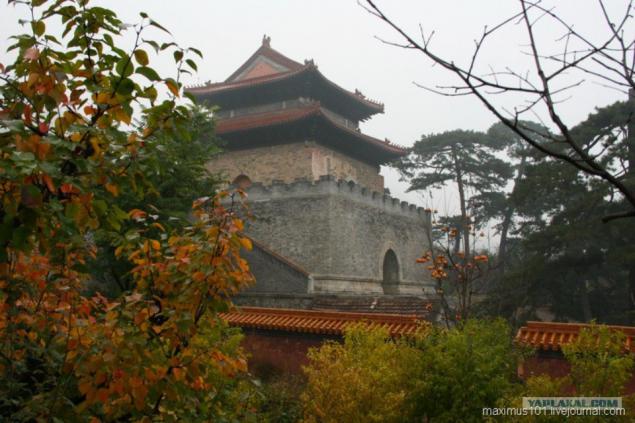
Source:
For the first time in the history of China has opened the tomb of one of the emperors - Wanli, which is now demonstrating to tourists. So now, not only Shisanlin majestic memorial Minsk imperial dynasty, but also a monument to the painful birth of Chinese archeology ...
38 photos
via maximus101
1. The corridor leading to the burial chamber of the tomb Dinlin.

2. You can often hear that this necropolis is not impressive, even in spite of its enormous historical significance. I probably agree, in my opinion, dumping the Qing emperors in Tsindunline east of Beijing is much more interesting, there are more tombs open to the public and the district itself is not so "spoiled" by human activity. Ming tombs are located too close to Beijing and in connection with this entire complex is built up much various outbuildings, settlements, etc.

3. But Shisanlin has an advantage, it is, above all, the huge size of the tombs. However, due to the fact that the burial hills heavily overgrown forest and economic development around the chaos, it is not very obvious to tourists. But the fact remains - for example, the diameter of the burial hill, first buried here Emperor Yongle, is 310 meters, and a circle about 1 km! I have no idea, what is the height of the mound was in the 15th century when it was built, but now it's somewhere meter 30. It is clear that the earth is "settled" for centuries, rain and wind do their job. But even now, the burial mound Yongle can compete in size with the ancient pyramid of China's first emperor Qin Shi Huang, under Xi'an, which also lost much in height over the millennia. Only a few have ever seen the pyramids in China fall short of the area to the Ming Emperor Yongle of the mound.
The layout of the mausoleum of Emperor Yongle, something like almost all vygledyat Ming tombs.

4. There is an interesting touch on the question of the form of burial structures of the Ming dynasty. It is unclear why the Ming emperor chose circular burial mounds. The fact that all the old Chinese burial hills, namely Tsin, and Han Sung pyramids were always exclusively a square base. Only the states of Northern Wei emperors built the "round" pyramidal structures, but it was kitaezirovannaya nomads tobgachey Dynasty, "the Chinese are not quite", so to speak. Visions of me pyramid subsequent Chinese Tang and Song dynasties have been square in plan, like all the others. The question arises why the emperors of the Ming Dynasty overthrew nomadic, again, the Mongol Yuan dynasty, and considers himself a real Chinese, and the best traditions of the Han state, changed the shape of their graves? After all, in the Chinese tradition - it is not an empty phrase. To this I have no answer ... The outer wall of the burial tomb Dinlin hill. The wall serves as additional protection of burial chambers and did not allow the earthen mound "sprawl."

5. Kurgan Dinlin.

6. Upper Playground wall strengthens burial mound.

7. The road to the tomb Dinlin.

8. All Chinese burial structures have almost the same structure - it's a long road to the main complex, fenced walls, inside the walls of a few yards from the wooden pavilion - a temple for the Souls of emperors and, actually, the burial mound. They differ only in size and degree of preservation.
Ruins "memorial hall".

9. "Funerary Tower" - the tomb Kanlin Fanchen.

10. So watch all the 13 tombs in Shisanlin has no thoughts, especially almost all of them are closed for visiting, you can not even get into the courtyard, you can only stare from behind the walls. Private entrance to the tomb Kanlin.

11.

12. The courtyards are open only three Changling Tomb, Dinlin and Zhaolin - Emperor Zhu Di, the motto of the Board Yongle (1360-1424 gg.), Zhu Inzyun motto Wanli reign (1563-1620 gg.) And Zhu Tszayhou motto Luntsin ( 1537-1572 gg.) To avoid confusion, I mention here only the motto of the emperors - Yongle, Wanli, etc. The main memorial hall of the tomb of Changling - Linendyan.

13.

14.

15. Now, at that time the authorities in China are very reluctant to opening the imperial tombs. Despite the external "communist gloss", the Chinese rulers strongly influenced by Confucian morality and various forms of folk beliefs, the belief in spirits, the notorious feng shui, etc. Therefore disturb ashes of the emperors considered not very useful for the society in general and the governor, in particular, employment. It can be self-fulfilling "displeasure spirits", and something goes wrong, in general, it is better not to risk it. And in order to justify it somehow obscurantism, the Chinese authorities have come up with various reasons, do not touch the tomb, for example, says that "we currently do not have the equipment to secure the preservation of historic values." Very often this is indeed so, but the striking fact that the tomb be opened less important people are very active. Do not touch only the significant characters of Chinese history. Apparently, it is believed that the "powerful" the emperor was in life, the more trouble may happen by opening his grave ...

16. Tomb of the great Emperor Yongle, the conqueror of the Mongols, the builder of the Forbidden City in Beijing, sent the Admiral Zheng Heh sail on the seas, would open in 1956, but still lay. The same thing happens with the famous pyramid of the first emperor Qin Shi Huang. By the way, here, in my opinion, has a well-known myth about the birth of the Chinese pyramids and their supposedly terrible inaccessibility, popular rumor is always under some kind of a base. The Chinese, in fact, trying to distance himself somewhat in this regard and little cover their research graves. My opinion is that they can not until the end decide for themselves how to develop its archeology and at the same time honor the memory of great ancestors.
Tower Fanchen before burial mounds Changling, Emperor Yongle. Very often in this tower began descending tunnel leading to the burial chamber.

17.

18.

19. The often cited example of the fate of the first opening of the imperial burial - in the tomb Dinlin Shisanlin. Initially, in 1956 there was a plan of excavation of the large mound necropolis in Minsk Changling - Emperor Yongle, it approved the "second sun" of the Communist Party of China - Zhou Enlai. But then, "because of the high social significance" Changling tomb, it was decided to work out at the "archaeological research" on anything more "shallow", this was the burial place of Emperor Wanli, the tomb Dinlin.
Linendyan Pavilion Changling tomb.

20.

21. Wanli famous in Chinese history only by its gluttony and extravagance, though propravil much as 47 years, so it would not dig so sorry. Besides, his tomb was too large in size, the diameter of the burial mound Dinlin 230 meters, it was possible to train enough.
Without much effort hit several mines in the interior of the mound Chinese "archaeologists" found the burial chamber Wanli. And then it turned out that was completely untouched Dinlin tomb. In the main crypt he attended Wanli himself, his two wives and their many riches. All more or less valuable, according to the ideas, the then Chinese "scholars" were gutted from burial chambers, first of all, it was the jewelry, and the rest of the "garbage", in the form of wooden sarcophagi, silks, various utensils and most Wanli wives was dumped in a shed.
Photography remains Wanli made in 1956 during excavations Dinlin. I must say that for his age, and it took almost 400 years old, he is very good looking ...

22. The story is not over the ill-fated Emperor, during the subsequent Cultural Revolution, the remains of Wanli and his wife were solemnly burned the Red Guards, a large gathering of people. Thus it was finally destroyed by the tyrant bloodsucker and the common people. By the way, most of the "archaeologists" digging Dinlin, also survived the Cultural Revolution.
Hats from the tomb of the imperial family Dinlin.

23.

24.

25. In today's day Chinese academia like to cite an example of "research" in Dinlin and add at the same time - do you really want all the other graves would be the same thing ... So it is better not to touch anything ... And still more to dig the graves of petty officials and concubines .
The funeral hall in Dinlin intended for concubines. He remained empty. Mountain green paper on the floor - Chinese yuan.

26. The main burial room with a mock coffin Dinlin Wanli and his two wives. Layouts are made quite clumsy, I personally can not believe that the imperial tombs were established, all I've seen a real Chinese sarcophagi were very elaborately decorated, it is unclear why the coffins Dinlin are exceptions ...

27.

28. The long hall at the entrance to the main burial chamber.

29. Lamps have been filled with oil and had to shine forever ...

30.

31.

32. Exit the tomb, these structures were built in 60 years, instead of the horizontal tunnel. Naturally, the historic entrance to the tomb was completely destroyed.

33. Why was it necessary to fence these modern designs are not very clear. By the way, the entrance to the tomb through a similar mine with ladders, the mine falls into the "Hall of concubines."

34. The modern way to the surface, most likely, these Chinese designs were necessary to hide, they dug during the excavations, monstrous excavations in the burial hill.

35. Stella turtle at the entrance to the tomb of Changling, the turtle is simply awash in cash.

36.

37. The outer wall of the burial hill Kanlin and classical Chinese landscape in the background. Ming Tombs worth seeing if only for the local mountain scenery.

38. Autumn in Shisanlin.
All

Source:
